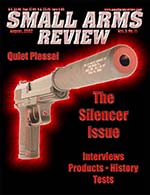Industry News: August 2002
By Robert M. Hausman
Inaugural SHOT Show University A Huge Success
Some 150 highly-motivated and eager-to-learn shooting, hunting and outdoor sports retailers arrived at the SHOT Show a day early this year and jammed into the several “classrooms” within the Las Vegas Convention Center designated for the inaugural edition of Shot Show University. The series of highly-valuable seminars designed to help retailers improve their management techniques, as well as their financial bottom lines, was held Friday, February 1, 2002 from 1 P.M. to 5 P.M.
Presented by leading industry experts, the curriculum included: Sales Floor Analysis, Personnel Management, How To Develop an Annual Strategic Plan, Retail Information Technology, Implementing Inventory and Record-Keeping Practices, and Direct Database Marketing.
In one of the best-attended seminars, “Sales Floor Analysis or Am I Making Money Yet? Tom Shay, a fourth generation merchant, presenter of Profit-Plus retailer profit-making seminars, detailed how retailers can analyze their store’s performance to maximize profit-making opportunities while finding and correcting weak-performing areas.
To begin, retailers should determine their average ticket size, Shay said. This is done by dividing your total annual sales volume (in dollars) by the total number of sales your store conducts over the course of a year. To further define how well your store is doing, you should determine the total of your sales per square foot of display space. This figure is readily found by dividing your store’s total annual sales by the total square footage of your store. You can then begin to think in terms of maximizing your available space by displaying popular products that give you a good return on your investment.
Why is sales floor analysis important, you might ask? It is because 53% of consumers think that all retail businesses look the same, research has found. Also, 74% of consumers base their perception of what you sell based upon the exterior appearance of your store. “Stores with a high average sales ticket and stores with high sales per square foot do not happen by accident!,” Shay exclaimed.
What gets a customer’s attention? Shay said consumers consider several factors when considering whether to make a purchase. These include: Will the merchant take care of any problems that later develop with the purchased merchandise?; the quality of the merchandise on display; the range of product selection; whether your store’s sales prices are really legitimate sales; and how the store seems to be managed (in other words, Does your store project a degree of professionalism?).
Other factors Shay said consumers consider are: the store’s commitment to a product category (in terms of breadth of inventory, knowledge and advice); the organization of the merchandise particularly in regard to saving the customer time in making a selection; Does the outside of the store appear to make it worth going in to?; Does the store’s appearance match its advertising? And, Does the desired product for purchase seems to be part of a fringe category within the store’s overall product mix.
Further, consumers also take into consideration: whether or not a store sells outdated or used merchandise; whether a store carries name brands; if they are products on shelves that obviously have been on display for a long time; Does the store show concern for its customers’ safety by having a well-lit parking lot, shoveling snow and removing ice from the lot and entranceway during winter time, etc.; the knowledge of the sales staff; the uniqueness of the store; Is the store easy to get in and out of?; and if the store does a good job of displaying merchandise and doing product demonstrations.
Shay said research has determined that over 60% of the consumers visiting your store take these traits into mind when deciding whether or not to make a purchase. In fact, if you target customers under the age of 35, they are 50% more likely to take these store traits into consideration than consumers over the age of 45.
Visual Merchandising
Shay next moved on to the area of visual merchandising and offered 13 keys to great visual merchandising. These included: use of signs inside and out; keeping high dollar items and whole goods at eye level; keeping staple items at the rear of the store to force customers to walk by other merchandise displays; maintaining an attractive entrance; designing your traffic flow through the store; building display with add-on items; keeping lots of impulse items on display; display a season ahead to get customers thinking about buying new gear for future activities; appeal to as many senses as possible in decorating and stocking your store; and, keeping related items in the same section and facing each other.
Six of the most common errors retailers make when designing their stores are: not maintaining a logical front to back arrangement: not using exterior walls to display merchandise; not using focal points to get people to move to opposite walls; not having a “power” or main aisle; not targeting a specific type of customer and, not using the windows to motivate people to enter the store.
The author publishes two of the small arms industry’s most widely read trade newsletters. The International Firearms Trade covers the world firearms scene, and The New Firearms Business covers the domestic market. Visit www.FirearmsGroup.com. He may be reached at: FirearmsB@aol.com.
This article first appeared in Small Arms Review V5N11 (August 2002) |
| SUBSCRIBER COMMENT AREA |
Comments have not been generated for this article.



